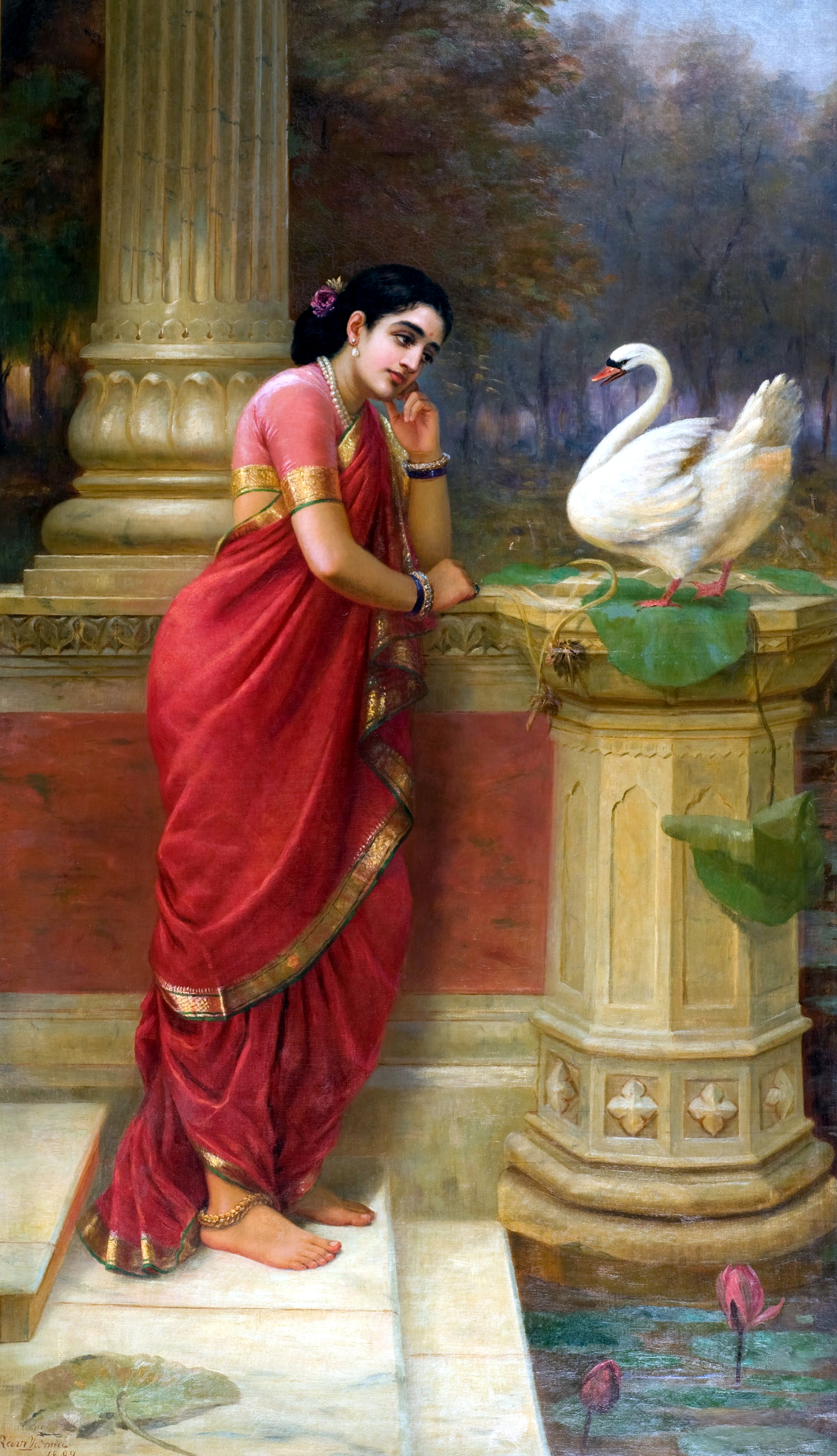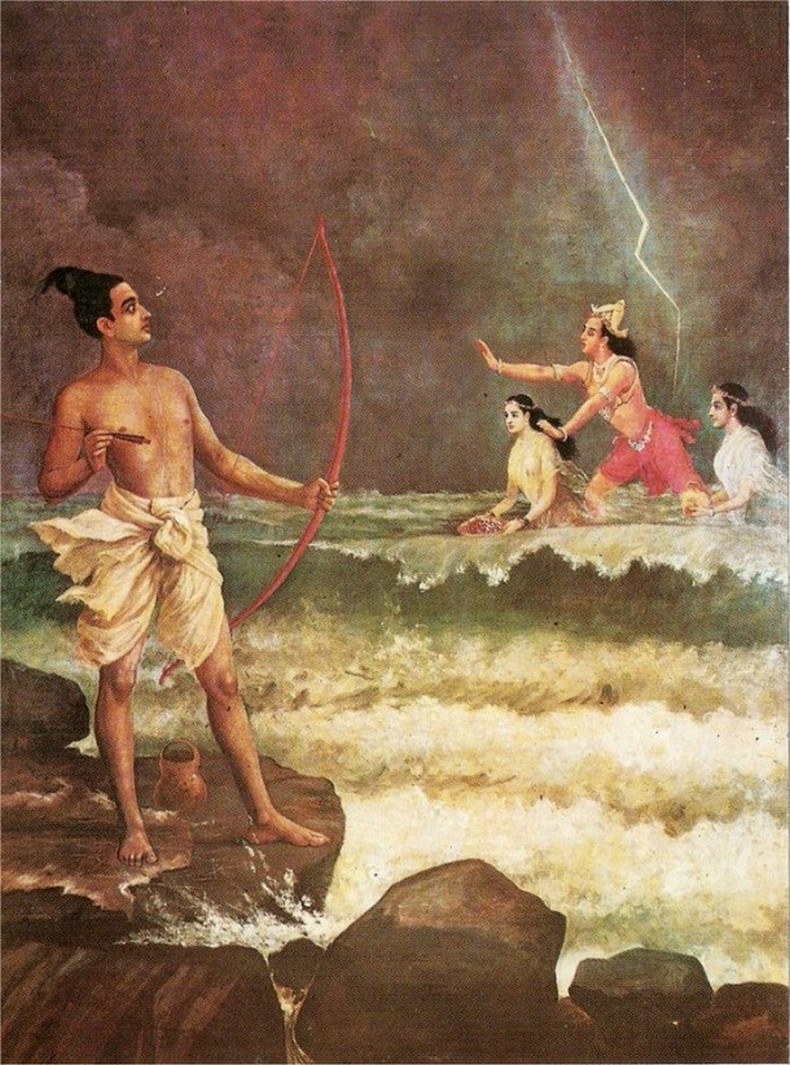Raja Ravi Varma : The Artist of Mythological Scenes
 |
| Hamsa Damayanti Raja Ravi Varma, Public domain, via Wikimedia Commons |
Raja Ravi Varma (1848–1906) wasn’t simply a painter; he was a visionary who understood how to bridge the timeless grandeur of Indian mythology with the technical mastery of European art traditions.
And as you explore his work, you begin to realize that his genius lay in how he made gods and goddesses, princes and princesses, look not like distant celestial beings but like people you could meet, speak to, and admire in everyday life.
The Man Behind the Brush
When you imagine Ravi Varma at work, you might picture him in his quiet Kilimanoor studio, a man of modesty, humility, and deep religious devotion. These weren’t just personality traits—they shaped every decision he made on the canvas. You see his values reflected in the way he painted women, the way he treated sacred stories, and the respect he held for his subjects.
Even though he was working in an era when European realism was becoming fashionable, he never abandoned India’s narrative traditions. Instead, he asked himself: How can I make these ancient stories feel alive for my people today? His answer became his life’s work—mythological paintings that could speak to a grandmother reciting the Ramayana, a child hearing the Mahabharata for the first time, and even an art patron in London seeing Indian epics through fresh eyes.
Blending Two Artistic Worlds
 |
| Raja Ravi Varma, Public domain, via Wikimedia Commons Sri Rama Vanquishing the Sea |
You realize he wasn’t imitating Europe—he was transforming it to fit India’s spirit. In his paintings, the folds of a sari fall with the same natural grace as a European gown, but the patterns, colors, and textures are unmistakably Indian.
His landscapes might use Western perspective, but they’re filled with banana groves, temple courtyards, and palatial verandas familiar to you.
The Women of Ravi Varma’s Mythology
As you move from painting to painting, you can’t help but notice that women dominate his mythological works. But you don’t see them as ornaments or symbols of desire. Instead, you see queens who carry themselves with regal poise, goddesses whose calm gazes radiate compassion, and heroines whose inner strength shines through every brushstroke.
When you stand before his Lakshmi, you feel her blessing flow through the gold and crimson hues. When you see Saraswati, holding her veena, her eyes tell you she is more than a muse—she’s the embodiment of wisdom. Even in more intimate scenes, like Damayanti talking to the royal swan, you sense purity, dignity, and emotional depth.
By portraying women as complete individuals—spiritual, moral, and graceful—Ravi Varma quietly reshaped how Indian femininity would be seen in art for generations.
From Kilimanoor to the Royal Courts
Your journey through his life starts in Kilimanoor Palace, his ancestral home in Kerala. Here, a young Ravi Varma learns the basics of art under a local watercolorist. You can imagine him, brush in hand, watching the pigments spread across the paper, already dreaming of grander compositions.
Then his talent catches the attention of patrons, and fate leads him to a British artist who teaches him oil painting—a revolutionary medium for Indian artists at the time. This changes everything. Suddenly, Ravi Varma can achieve depth, richness, and realism that traditional tempera or watercolors couldn’t provide. He begins experimenting with shading, perspective, and naturalistic textures, elements that would define his style.
 |
| Shakuntala and Sakhis Raja Ravi Varma, Public domain, via Wikimedia Commons |
Painting the Epics: Mahabharata and Ramayana
As you follow Ravi Varma’s artistic journey, you see how deeply he immersed himself in India’s epic stories.
Damayanti and the Royal Swan
Every fold of the fabric seems to breathe with the gentle breeze imagined in the painting. Her eyes, large and luminous, are fixed on the swan before her—no ordinary bird, but a celestial messenger.
The swan, captured mid-sentence with its beak slightly open, looks almost alive. Its feathers are painted with such precision that you can imagine their softness. Its wings curve in a subtle arc, hinting at both grace and divine purpose. You sense that it carries not just words but the weight of fate itself.
The background is serene: a soft landscape of water lilies, tranquil waters, and distant palace towers. You can almost hear the quiet lapping of water, the faint rustle of leaves. This stillness mirrors the emotional calm Damayanti must feel as she listens to the swan relay King Nala’s declarations of love. In that instant, you realize this is more than just a meeting—it’s the moment destiny sets its course, captured forever in paint.
Draupadi’s Plight
 |
Raja Ravi Varma (1848 - 1906), Public domain, via Wikimedia Commons ''Draupadi Vastraharan'' c. 1888 -1890 |
Draupadi stands in the center, her sari being pulled in a cruel act meant to strip her of dignity. Her eyes—large, imploring, desperate—are fixed upward, seeking Krishna’s divine intervention. You feel her silent cry in your bones, as if she is asking you personally to bear witness to this injustice.
Around her, the court is a theater of cruelty. The Kauravas’ faces are twisted with arrogance and malice, their postures exuding dominance. Some in the crowd avert their eyes in shame, others watch with morbid satisfaction. You sense the collective failure of the court’s morality, the collapse of dharma in the very place meant to uphold it.
Ravi Varma uses light to powerful effect here. Draupadi is bathed in a glow, her figure standing out starkly against the darker tones of the assembly hall. This illumination feels symbolic—a beacon of virtue surrounded by shadows of corruption. The folds of her sari multiply in the scene, subtly showing the miracle of Krishna’s protection, where every attempt to disrobe her is thwarted. You can’t walk past this painting casually; it demands you pause, reflect, and feel the injustice that changed the course of the Mahabharata.
Shakuntala’s Love
 |
| Sakunthala Pathralekhan Raja Ravi Varma, Public domain, via Wikimedia Commons |
Finally, your gaze rests on Shakuntala writing a letter to Dushyanta, and a softer, more wistful mood takes over. You are transported into the dappled green of a forest clearing, the kind of space where light filters through the trees in golden shafts. Shakuntala sits on a low stone bench, surrounded by gentle wildflowers and the murmurs of nature.
She leans slightly forward, her slender wrist arched gracefully as she holds a palm leaf and stylus. Her head tilts just enough to suggest both concentration and longing. You see it in her eyes—the quiet ache of a heart waiting for a reply, the hope that her words will bridge the distance between her and the king who once pledged his love.
Her garments are simple yet elegant, the earthy tones harmonizing with the natural setting. Her hair is adorned with fresh flowers, their petals echoing her innocence and purity. Ravi Varma surrounds her with life—birds in the branches above, a gentle deer grazing in the background—subtly reinforcing the idea that love itself is part of the natural order.
Even without knowing Kalidasa’s play, you understand the essence: this is love in its most tender and vulnerable form. It’s the act of committing one’s emotions to words, not knowing if they will be received or returned. And as you stand before the canvas, you feel yourself silently urging Dushyanta to remember her, to answer her longing with the devotion she so clearly deserves.
The Influence of European Salon Art
As you move through his work chronologically, you see how European salon art influenced his compositions. His canvases grow larger, his subjects more dramatic, his backdrops more elaborate. Yet, the stories remain rooted in Indian soil. He uses oil paints with gold-like richness, creating a timeless glow that still feels alive today.
Democratizing Mythology Through Prints
You might think his influence was confined to royal patrons and art connoisseurs. But Ravi Varma wanted every household to have access to these mythological images. That’s why he started a lithographic press—a bold move for the late 19th century.
Imagine yourself in a small Indian town in the 1890s. You walk into a bazaar and see colorful prints of Krishna lifting Govardhan Hill, Arjuna receiving the Bhagavad Gita from Krishna, or Sita in Ashok Vatika. These aren’t just decorations; they’re cultural touchstones, bringing epic narratives into everyday homes.
Standing Before a Ravi Varma Painting Today
When you stand before one of his mythological works in a gallery—perhaps at the Sri Chitra Art Gallery in Thiruvananthapuram—you feel time dissolve. The oil paint glistens under the light, the colors still vibrant despite the century that has passed.
You notice the meticulous jewelry detailing, the natural skin tones, the folds in garments, and the play of shadow and light on every figure. His gods and goddesses don’t feel unreachable—they seem to be looking right at you, ready to step off the canvas and speak.
Why His Mythological Paintings Still Matter
Today, as you scroll through social media or watch Indian cinema, you might see echoes of Ravi Varma everywhere. Filmmakers borrow his framing for divine characters, calendar art still follows his visual templates, and even temple murals sometimes adopt his compositional style.
Why? Because he gave India a visual identity for its gods and heroes—one that merged realism with devotion, making mythology something you could not only read or hear but truly see.
Your Takeaway from Experiencing His Art
When you leave a Ravi Varma exhibition, you carry more than the memory of beautiful paintings. You carry the feeling of having stood in the presence of Sita’s quiet strength, Lakshmi’s gentle benevolence, Krishna’s playful charm, and Arjuna’s noble resolve.
You realize that through his art, Ravi Varma gave you a way to connect with your cultural roots while appreciating the global language of fine art. And in doing so, he ensured that India’s epic tales would continue to live—not just in texts, but in the colors, forms, and faces that speak directly to your heart.Keywords: Raja Ravi Varma paintings, Raja Ravi Varma mythological paintings, Indian art history, Mahabharata paintings, Ramayana art, Indian oil painting, Damayanti and the royal swan, Indian epic art, Lakshmi painting, Saraswati painting.